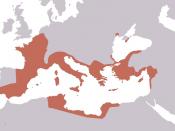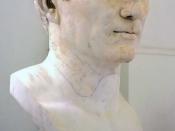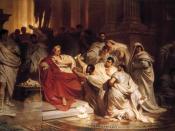Western Civilization Final Section I 1) Rome enjoyed many years of lavishness and magnificence. However, Rome was not unaccustomed to civil unrest and political upheaval. The most common occurrences of the second century were war, revolt, rivalry between dictators and assassinations. Slave uprisings were common. A revolt of some 70,000 slaves managed to defeat a small army in Sicily in 134 B.C.E.
Nevertheless, the revolt was stopped by subsequent Roman armies. the most famous of such uprisings was a slave rebellion led by a man named Spartacus, a trained gladiator, from 73-71 B.C.E.
Years earlier, conflict between the upper class of Roman society began to unravel. Two brothers, Tiberius and Gaius Gracchus, designed an answer to soothe social and economic stress by granting land to those who had nothing. Tiberius then proposed a law that was to limit how many acres renter and holders could govern, the excess would be given to the poor.
Many men in government adamantly opposed the law and had it vetoed. Octavius had a major hand in its veto, therefore, Tiberius had Octavius removed from office. Time came for Tiberus to be reelected.
Many citizens began to fear that Tiberus was moving toward a dictatorship. These scared and outraged citizens acquired clubs and proceeded to murder Tiberus during the election.
Years later, Tiberus' brother, Gaius, saw Tiberus' land act put into action. However, Gaius felt he had to go further with reform. He was elected in 123 B.C.E. and again in 122. He then was able to do more for the under privileged. One law provided a stable price for grain , another took control of governors who were suspected of capitalizing on the provinces for their own advantage. These and other actions of this kind enraged the other members of the senate.
They planned to exterminate Gauis. With that, the Roman senate proclaimed Gauis Gracchi public enemy number one and authorized the consuls to take necessary steps to be rid of Gauis.
Gauis was murdered, like his brother, along with thousands of his followers.
After Gracchi's death two military leaders emerged as rulers of the state. The first was Marius who stayed in office for seven consecutive years, accomplished nothing. With Maruis' death the aristocracy took over and elected Sulla, another military commander. Sulla was appointed dictator in 82 B.C.E for an unlimited amount of time. He proceeded to do away with all persons who stood in opposition of him. He extended the power of the aristocracy and discharged many powers of the tribune. Sulla ruled for three years, tired of the job, and retired.
Before he retired he left power to the selfish Roman aristocracy. This action brought forth two prominent military rulers.
Pompey ( 106-48 B.C.E.) and Julius Caesar (100-44 B.C.E.) rose and together sought control of the government. Eventually Pompey and Caesar became mortal enemies. Each sought support by popular vote from Roman citizens. Pompey won popularity as a conqueror of Syria and Palestine. Caesar channeled his energy to the northeast into a series of take overs against the Gauls. While Caesar was away, a number of rebellions occurred in 52 B.C.E. The Roman senate turned to Pompey for help. Pompey took office and then took actions to have Caesar labeled an enemy of the state. He intended to cut off all of Caesar's political power. This action proved to be a fatal mistake for Pompey. Hearing of the news, Caesar turned his troops toward Rome.
Pompey fled to the east and was eventually murdered by supporters of Caesar.
Once in power, Caesar bent the senate to his every desire. In 46 B.C.E, he became dictator for ten years and he achieved full power of the senate to make war and peace. In essence, he essentially had control of Rome. Caesar's demise came about as rumors spread that he was to make himself king. Fear of this led to Caesar's assassination on the Ides of March in 44 B.C.E.
by conspirators led by Brutus and Cassius, Romans detested kings.
By the first century B.C.E, Rome was the dominant force in Western Europe. It had enveloped Hellenistic, Greek, territory and destroyed the North African civilization of Carthage bringing the Mediterranean area into the fold of Roman rule. These actions brought Hellenistic institutions and ideas to the Roman world. For years Roman greatness was firmly established in these traits: respect for tradition, political order and military mastery. These qualities together with Greek philosophy and all the attractions of the Greek culture contributed to much that was grand in Roman society. Roman culture exploded with majestic substance. The conquest of Carthage not only enlarged the Roman empire, it led to new territories in Sicily, Africa and Spain.
This brought in vast quantities of Sicilian, African grain and Spanish silver. A huge increase in slavery came about from prisoners of war, thereby enabling agriculture production to soar. With economic change came social change. The introduction of free marriage worked toward greater equality for women in marriage. Under free marriage a woman was able to keep her father's wealth as her own. With that came new divorce rules: either partner could initiate proceedings.
The upper class became wealthier with each conquest. This enabled them to give children more education in the arts, theater and literature. The intellectual pursuits previously enjoyed in Grecian society were emerging among Roman society. Of course with excessive wealth and productivity come criticism. Juvenal ( c. 55-130 C.E.), a Roman poet, expressive his disgust with an increasing slobbish and lazy Roman society in his writing entitled "Satires"�.
Insomnia causes more deaths amongst Roman invalids Than any other factor (the most common complaints, of course, Are heartburn and ulcers, brought on by overeating.) How much sleep, I ask you, can one get in lodgings here? Unbroken nights--and this is the root of the trouble-- Are a rich man's privilege, The waggons thundering past Through those narrow twisting streets, the oaths of draymen Caught in a traffic-jam--these alone would suffice To jolt the doziest sea-cow of an Emperor into Permanent wakefulness.
The Greek philosophy of Stoicism was introduced into Rome and soon had a following of numerous leaders in public life. The period of the Principate (27 B.C.E.-180 C.E.) brought about intellectual and artistic achievements that outshone any other age of Roman existence. The golden age of the Principate saw the introduction of Roman poets such as Virgil (70-19 B.C.E.), Horace (65-8 B.C.E.) and Ovid (43 B.C.E.-17 C.E.).
The silver age of the Principate brought about the satirist Juvenal (55-130 C.E.) and Tacitus (55-117 C.E.), the historian, just to name a few. Roman enjoyed literature, art architecture and comfortable living. From the time of Agustus Caesar (63 B.C.E-14 C.E.) until the death of Marcus Aurelis in 180 C.E., Romans lived life in peace and luxury.
2) The turning point for Rome came with the murder of the wicked Roman Emperor Commodus in 192 C.E. Commodus did not leave a successor and Roman law did not give a clear answer as to who should replace him. In Rome no one knew the answer to this perplexing question. This oversite eventually led to civil war. This confusion and lack of reform usually resulted in overthrowing the government. This violent action would lead to more violence by officials competing to control the masses. Many Roman citizens did not participate in government, therefore they felt as if they were not allowed to contribute to Roman rule. This resulted in citizens looking upon government with hostility and indifference, especially when tax collection time came.
Regardless of the political problems, Rome would have eventually perished because of economic problems. The Roman slave system was lacking in quality man power, thus cities became unable to produce enough agricultural produce. The slaves that Rome did acquire did not usually work to their full potential because of intense mistreatment. The working conditions in which slaves had to work under ,in the gold and sliver mines, has been described by Greek historian Diodorus Siculus (c 80-29 B.C.E) in his work called "On Slavery in the Late Republic"�.
Siculus notes, For no respite or pause is granted them in their labours, but compelled beneath blows of the overseers to endure the severity of their plight, they throw away their lives in this wretched manner, although certain of them who can endure it, by virtue of their bodily strength and their persevering souls, suffer such hardships over a long period; indeed death in their eyes is more to be desired than life, because of the magnitude of the hardship they must bear (Siculus 217).
The previous years of Roman peace saw the slave population decline. Without an age of war, which usually brought in captives for slavery, Roman men were increasingly needed to work the farms. But Rome also needed men to fill the positions in the army as well. Not enough strong Roman men in the right places left Rome open to invasions. Years past in the second and third centuries plagues swept across Europe killing many citizens and contributed to the shortage of qualified men. High taxes, unruly government and civil war and lack of agricultural productivity weighed heavily on the average Roman citizen. This strain eventually left citizens with being unsupportive and disinterested in the future of Rome. This left Rome vulnerable to pressing forces in the west from the fierce Germanic tribes.
3) The Germanic tribes came upon Rome during a defenseless time. Rome was experiencing problems from within its systems of organization. The Germans were able to use this to their advantage and took Rome with some ease. Had Rome been as it was before the death of Marcus Aurelius, the Germans may not of been so successful. Roman citizens lacked a spirit of unification. Without a strong Roman opposition, Germanic tribes were able to cripple western Rome without much force. Where Caesar and Augustus once ruled, Germanic Kingdoms established the new government. It has been a common misconception that the Germanic tribes were ill-mannered savages who destroyed Rome out of hatred for the civilization.
They were not city dwelling individuals, they practiced settled agriculture and were hunter/gathers. They made sophisticated iron tools, weapons and jewelry. Physically they looked like Romans and intermarriage with Romans occurred in many cases, especially on the frontier, without much concern. Their language, Indo-European, was related to Latin and Greek.
Germans and Romans who shared a common boarder along the Rhine and Danube Rivers interacted through steady trading. Even during times of war, Romans and Germans were often allies.
The German invasion of the Roman Empire was not aimed to destroy Rome, but to seek better cultivatable land. The Visigoths set their eyes on Roman territory in 378 C.E. Because of mistreatment by Roman officials the Battle of Adrianople too place. The Germans defeated a small Roman army; however, they did not act upon their victory because they were bought off by the Empire of Theodosius the Great of the Eastern Empire. When Theodosius died in 395, land was divided between his two sons. Neither son was capable of administering an empire and political problems further weakened the heirs' status. The Visigoths took advantage of this situation and took Roman land as they needed it. By 410 C.E., they crushed Rome altogether.
Tacitus (c56-120 C.E.), a Roman literary scholar, described of the differences between the unspoiled Germans in a way that contrasted everything about the spoiled Romans he was living among. His Germania is the best source available on the Germanic tribes, If they are energetic, if they are conspicuous, if they fight in the front, they lead because they are admired. But to reprimand, to imprison, even to flog, is permitted to the priests alone, and that not as a punishment, or at the general's bidding, but, as it were, by the mandate of the god whom they believe to inspire the warrior (Tacitus 246).
Another group of allied Germanic tribes took advantage of the Visigoth situation and marched into Spain by way of Gaul. They then moved on to Northwest Africa, one of the richest agricultural regions of the Roman Empire. By 476 C.E., the end came for the Western Roman Empire as a German assumed the role of King of Rome. Consequences of the Germanic conquest were few. Germans replaced Roman landlords without much agricultural interruption. Rome was already in a state of decline and the take over aided and accelerated the progress of collapse.
3) The term, Renaissance, means "rebirth"�. An intellectual movement ranging from 1300 A.D. to about 1520 A.D. It manifested as an Italian event redefining many ideas of art, thought, literature and other aspects of the Italian social and cultural structures. It became an age that challenged the curiosity of men and urged them to explore and redefine everything they knew.
Many people of this time know of such classical Roman artist such as Virgil, Ovid and Cicero. But, others such as Livy, Tacitus and Lucretius were rediscovered and made familiar again. What was even greater was the discovery of such classical Greek artists as Plato. People were being exposed to the wondrous works of Grecian scientific and philosophical treaties. None of these works had ever been available because they did not have Latin translations. To remedy this, many scholars began studying Greek and eventually mastered classic Greek literature.. Not only were the people of the Renaissance using more classical themes, but they were thinking and using them in different ways. Another innovation was that general train of thought became more worldly rather than religious. By no means did the Church or religion become forgotten. People began to see their individual existence under the eyes of God as meaningful and significant.
The Renaissance began in Italy for many reasons. One reason is that Italy contained the most advanced urban society in all Europe. Because Italian aristocrats did not isolate themselves from public affairs, it enabled them to become exposed to other cultures. Because they did not gain their wealth from their estates, but through trade and mercantilism, they were exposed to many more ideals. This allowed the aristocracy to seek out new information. A great demand for skilled educators in reading and counting became necessary for a successful merchant business.
This necessity resulted in the search for proper teachers which, in turn, produced a large number of secular scholars. These teachers not only taught, but their qualifications began being introduced in such areas as politics, ethics and literature. This investment then produced the most educated upper-class society in all of Western Europe who were willing to invest in the growth of new ideas, forms of literature and artistic expression.
Giovanni Pico della Mirandola (1463-1494) was a figure who stands out in the history of Renaissance humanism because of his concept of the dignity of man. This encouraged him to write "Oration on the Dignity of Man"� , in which Pico clearly praised as a divine creation capable of enjoying whatever he wished.
At last it seems to me I have come to understand why man is the most fortunate of creatures and consequently worthy of all admiration and what precisely is that rank which is his lot in the universal chain of Being-a rank to be envied not only by brutes but even by the stars and by minds beyond this world. It is a matter past faith and wondrous one.
Why should it not be? For it is on this very account that man is rightly called and judged a great miracle and wonderful creature indeed (Mirandola 477).
.
Despite the many literary contributions of the Renaissance, the most enduring achievement of this time came from the art world. By the onset of the fifteenth century new discoveries of the laws of linear perspective were discovered. This contributed to the sense of three dimensional work. For the first time, artists began to encorporate the world around them into their art. They also began elaborating on the physical proportions of the human body. A good example of this is a sculpture executed by Michelangleo (1475-1564 A.D.) entitled David. Another work of Michelangleo's that represents and defines the Renaissance view of man was his painting done on the ceiling of the Sistine Chapel in Rome called The Creation of Adam.


